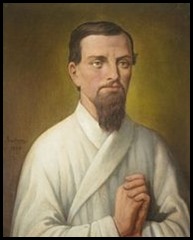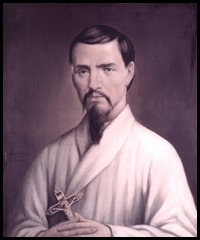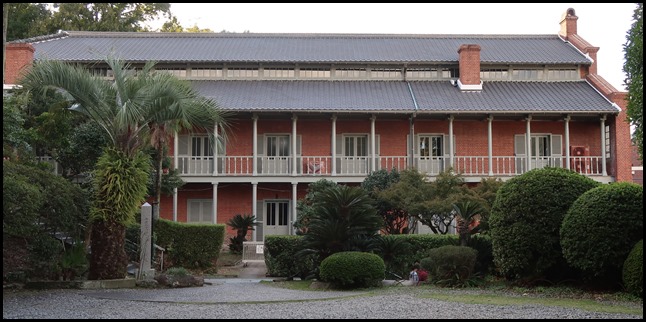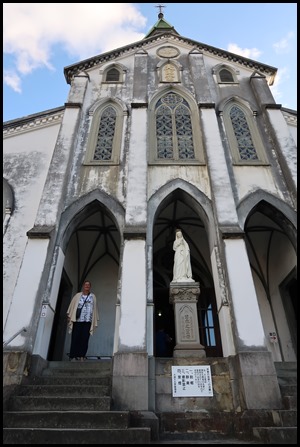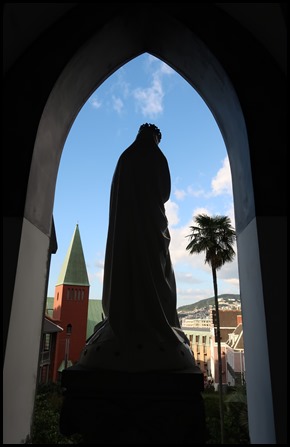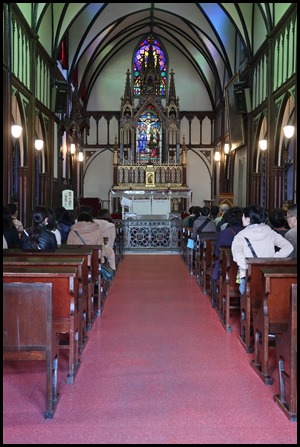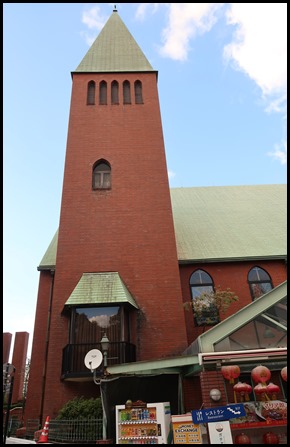Oura Church Part 2

|
Oura Catholic Church, Nagasaki – Part
Two 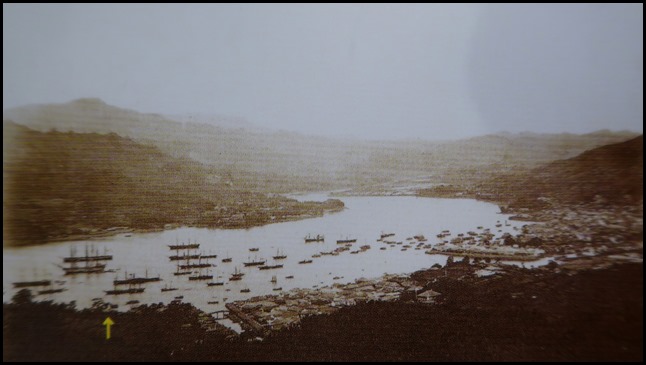 Nagasaki Harbour in the Meiji
Era We pay our entrance fee and the lady gives us a booklet
that contains some history: This photograph of the Nagasaki Foreign
Settlement and Nagasaki Harbor was taken from Mt. Hoshitori in 1868, three years
after the consecration of Oura Catholic Church. The arrow to the left indicates the church spire. Farmland
reclaimed from the harbor from around 1730 is visible in the upper reaches of
the bay to the right. The island of Dejima (right centre) remains unchanged. The
city streets of Nagasaki lie in the background, leading up to the site of the
Martyrdom of the Twenty Six Saints of Japan at Nishizaka. Strewn with foreign
ships, the harbor evokes the atmosphere of a new era of international exchange
after the Meiji Restoration (Nagasaki University
Library).
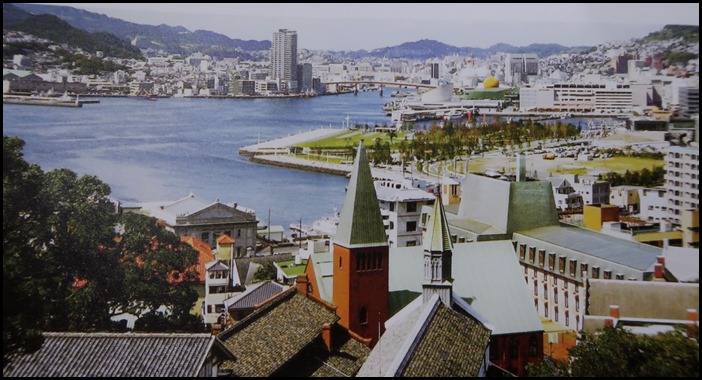
Since the consecration of Oura Catholic Church in 1865, the Nagasaki Archdiocese has overcome various hardships, not the least of which was the atomic bombing of 1945. Today it includes 130 churches throughout the Prefecture. Visible to the left of Oura Catholic Church is the red spire of the new Oura Church, where the faithful now celebrate Mass every day. The site of the martyrdom of the Twenty Six Saints of Japan at Nishizaka is hidden behind the cluster of buildings near Nagasaki Railroad Station. Once the haunt of steamers plying the Nagasaki-Shanghai Line, Dejima Wharf has been expanded into Mizube-no-Mori Park. Modern passenger liners anchor at Matsugae International Wharf below the Minamiyamate neighbourhood. Oura Catholic Church has withstood a century and a half of tribulations and continues its solemn vigil on the hillside overlooking Nagasaki Harbor.
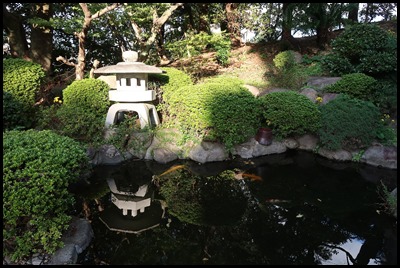 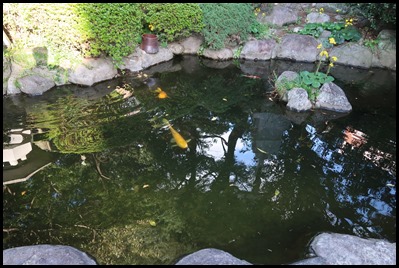
At the top of the first flight of steps was a courtyard complete with lantern, pond and koi.
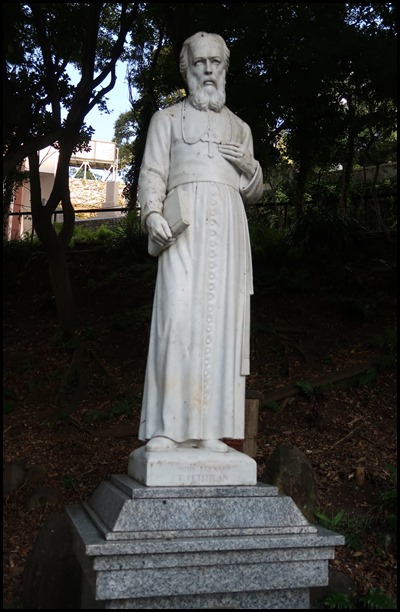
History: In 1863, two French priests from the Sociéte des Missions Étrangères, Father Louis Furet and Father Bernard Thadeo Petitjean, landed in Nagasaki with the intention of building a church honouring the Twenty-Six Martyrs of Japan, nine European priests and seventeen Japanese Christians who were crucified in 1597 by order of Toyotomi Hideyoshi. The church was finished in 1864. Constructed by the master carpenter of the Glover Residence, Koyama Hidenoshin, it was originally a small wooden church with three aisles and three octagonal towers. The present structure is a much larger Gothic basilica that dates from around 1879. This version was built of white stuccoed brick with five aisles, vaulted ceilings, and one octagonal tower. The design most likely came from a Belgian plan used by Catholic missionaries in an earlier church built in Osaka. The stained glass windows were imported from France. On the 17th of March 1865, Father Petitjean, was kneeling to say his evening prayers in the church, the first Christian church allowed in Japan in modern times. St Francis Xavier had begun his mission to Japan in 1549; Christianity was prohibited in 1614; the last priest was killed in 1644. All missionaries were either killed or expelled. All native priests had been executed, and thousands of Christians done to death, by burning, crucifixion, bombardment by Dutch gunners (the Dutch were not regarded by the Japanese as Christians), and various other modes of torture. Not a vestige of the religion – which at its height had claimed two hundred thousand adherents in Nagasaki alone – remained. As Father Petitjean prayed, he became aware of around a dozen Japanese standing at the back of the church, staring curiously. Father Petitjean went and introduced himself to them. Speaking in Japanese, he said: “I am a Christian Father.” A woman asked him: “Do you obey the Father in Roma?” “Yes.” “Do your priests marry?” “No.” “Do you observe the Sad Season and the Rising from the Dead?” “Yes.” Then: “Where is Maria?” In growing astonishment, Father Petitjean took the group to a statue of the Virgin and Child, which still stands to the right of the High Altar. The Japanese were evidently much moved, and the woman put her hand on her breast and said: “We are all of the same heart as you.”

Near to Father Petitjean is a memorial to four of the Korean saints.
After Bishop Berneux was executed during a campaign by the Korean government against Christians, Bishop Daveluy became apostolic vicar on the 8th of March 1866. He was promptly arrested on the 11th of March. Imprisoned and tortured, he staunchly defended his Catholic faith. Sentenced to death, he asked to be executed on the 30th of March - Good Friday. He was beheaded at a Korean naval base in Galmaemot near present-day Boryeong along with two French priests, Pierre Aumaître and Martin-Luc Huin, and two lay catechists, Lucas Hwang Sŏk-tu (Bishop Daveluy's personal assistant) and Joseph Chang Chu-gi. All five were canonised on the 6th of May 1984 along with Father Kim, Bishop Berneux and 96 other Korean martyrs. Father Luc Huin was arrested on the 12th of March 1866, and was sent to the Seoul prison with Bishop Daveluy and Father Aumaitre on the 19th of March. He was severely interrogated and tortured in Seoul. Then, with Bishop Daveluy and Father Aumaitre, he was transferred to Galmaemot. Following Bishop Antonius Daveluy and Father Petrus Aumaitre, Father Huin was beheaded last on the 30th of March 1866. He was 30 years old. Before he was martyred, he said, "I am sorry to die, neither because I am still young nor because I have to die so miserably, but because I have to die having done nothing for the salvation of my dear Korean people."
Antonious Daveluy, Martin-Luc Huin, Pierre Aumaître, Joseph Chang Chu-gi
Pierre Aumaître ordained a priest on the 14th of June 1862. He left for missionary work in Korea on the 18th August 1862, arriving in June 1863; he studied the language and customs in Seoul and Saemgol, and then began working in the Naep’o region. He prevented his parishioners in Saemgol from being interrogated and abused by government authorities, he surrendered in March 1866; he was taken to Seoul, imprisoned, tortured, and finally executed for his faith and his work A Korean pharmacist, Joseph Chang Song-jib was about fifty-three when he converted to the Catholic faith in April of 1838. Little more than a year later, he was arrested as the Korean government re-intensified its continuing persecution of Christians. Joseph's friends as well as those who had arrested him urged him to save his life by apostatising. He answered them, "There is one sovereign Master who created heaven and earth and everything contained in them. Mankind is therefore under an obligation to honour him...how could I, for the sake of this life which is so short, risk the loss of that greater prize which is eternal?" The next day, a government commissioner interrogating Joseph demanded that he deny his religion, to which the prisoner responded by giving a succinct description of the Catholic faith. For his impromptu catechesis, Joseph received a harsh beating of twenty blows with a wooden board. A day after this torture, he died in prison. Two years later, Joseph's brother, (Saint) Anthony Kim Song-u, was also to die a martyr's death.
Opposite the courtyard is the Latin Seminary – now a museum.
Outside, looking beyond Our Lady to the new church and inside.
The Basilica of the Twenty-Six Holy Martyrs of Japan or Ōura Church (大浦天主堂) is a Roman Catholic minor basilica and Co-Cathedral in Nagasaki, built soon after the end of the Japanese government's Seclusion Policy in 1853. It was for many years the only Western-style building declared a national treasure, and is said to be the oldest church in Japan. (Ōura Church was replaced by Urakami Cathedral as the Cathedral of the Nagasaki Archdiocese, own blog and very dramatic history).
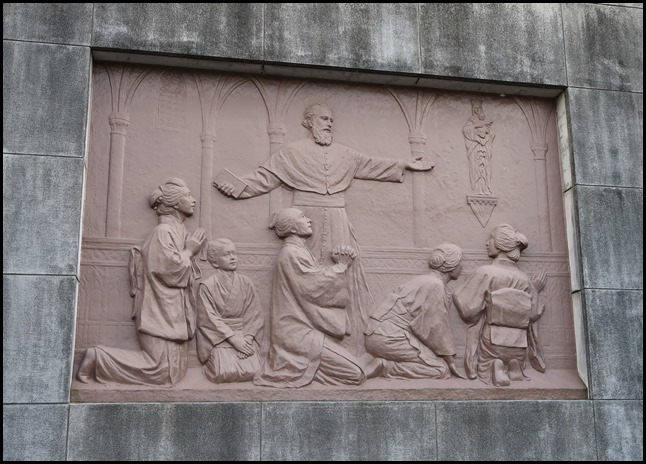
The bronze relief in the courtyard below the church shows the memorable scene of the discovery. Before long, tens of thousands of underground Christians came out of hiding in the Nagasaki area. News of this reached Pope Pius IX, who declared this "the miracle of the Orient." Ōura Cathedral was designated as a National Treasure in 1933 and again on the 31st of March 1953 under the 1951 Law for the Protection of Cultural Properties. It was the first Western-style building in Japan to be given this honour and had been the only one until 2009 when the neo-Baroque Akasaka Palace was designated a National Treasure. The church was granted status as a minor basilica by the Vatican Holy See on the 26th of April 2016 for its historical value.
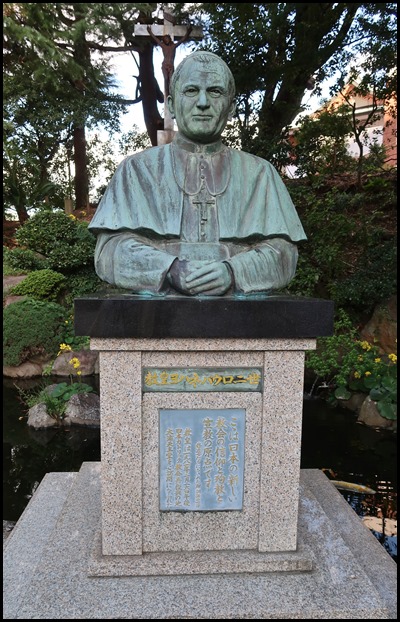
When Pope John Paul II visited the church in 1981 and heard the story of the Christian faith that had survived the centuries of harsh persecution, he was greatly moved and declared it to be the “Miracle in the East”.
We left the Oura Church and walked to the new Oura Church, sadly locked.
ALL IN ALL AMAZING TO FIND THE CHURCH STILL BE HERE QUITE SIMPLE AND LOVELY
|

